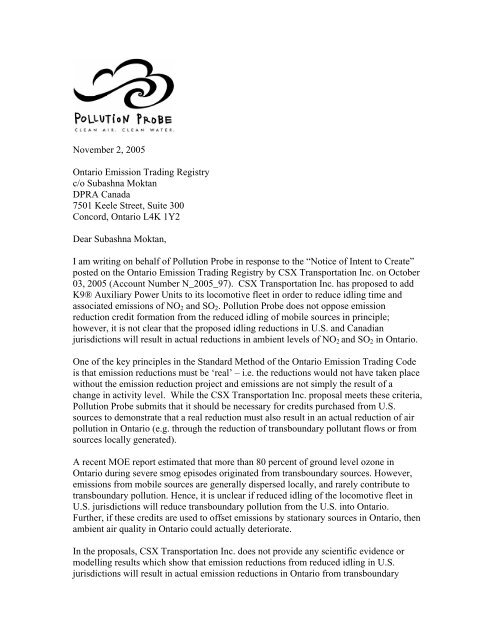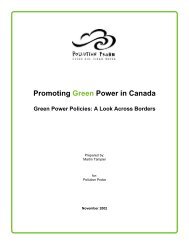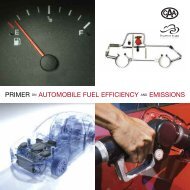Sudhir Khanna - Pollution Probe
Sudhir Khanna - Pollution Probe
Sudhir Khanna - Pollution Probe
Create successful ePaper yourself
Turn your PDF publications into a flip-book with our unique Google optimized e-Paper software.
November 2, 2005<br />
Ontario Emission Trading Registry<br />
c/o Subashna Moktan<br />
DPRA Canada<br />
7501 Keele Street, Suite 300<br />
Concord, Ontario L4K 1Y2<br />
Dear Subashna Moktan,<br />
I am writing on behalf of <strong>Pollution</strong> <strong>Probe</strong> in response to the “Notice of Intent to Create”<br />
posted on the Ontario Emission Trading Registry by CSX Transportation Inc. on October<br />
03, 2005 (Account Number N_2005_97). CSX Transportation Inc. has proposed to add<br />
K9® Auxiliary Power Units to its locomotive fleet in order to reduce idling time and<br />
associated emissions of NO 2 and SO 2 . <strong>Pollution</strong> <strong>Probe</strong> does not oppose emission<br />
reduction credit formation from the reduced idling of mobile sources in principle;<br />
however, it is not clear that the proposed idling reductions in U.S. and Canadian<br />
jurisdictions will result in actual reductions in ambient levels of NO 2 and SO 2 in Ontario.<br />
One of the key principles in the Standard Method of the Ontario Emission Trading Code<br />
is that emission reductions must be ‘real’ – i.e. the reductions would not have taken place<br />
without the emission reduction project and emissions are not simply the result of a<br />
change in activity level. While the CSX Transportation Inc. proposal meets these criteria,<br />
<strong>Pollution</strong> <strong>Probe</strong> submits that it should be necessary for credits purchased from U.S.<br />
sources to demonstrate that a real reduction must also result in an actual reduction of air<br />
pollution in Ontario (e.g. through the reduction of transboundary pollutant flows or from<br />
sources locally generated).<br />
A recent MOE report estimated that more than 80 percent of ground level ozone in<br />
Ontario during severe smog episodes originated from transboundary sources. However,<br />
emissions from mobile sources are generally dispersed locally, and rarely contribute to<br />
transboundary pollution. Hence, it is unclear if reduced idling of the locomotive fleet in<br />
U.S. jurisdictions will reduce transboundary pollution from the U.S. into Ontario.<br />
Further, if these credits are used to offset emissions by stationary sources in Ontario, then<br />
ambient air quality in Ontario could actually deteriorate.<br />
In the proposals, CSX Transportation Inc. does not provide any scientific evidence or<br />
modelling results which show that emission reductions from reduced idling in U.S.<br />
jurisdictions will result in actual emission reductions in Ontario from transboundary
sources. In addition, the CSX Transportation Inc. proposal does not identify the portion<br />
of idling reductions that will take place in Ontario and that will have an impact on local<br />
air quality. Unless such evidence can be supplied, <strong>Pollution</strong> <strong>Probe</strong> submits that the CSX<br />
Transportation Inc. proposal should be 1) rejected or 2) limited to emission reductions<br />
that can be verified as resulting from reduced idling within Ontario or from adjacent<br />
border regions where idling reductions will clearly have a positive benefit on Ontario’s<br />
air quality.<br />
We respectfully submit these comments and look forward to further discussions on the<br />
inclusion of mobile source emission reduction credits in the Ontario emission trading<br />
program.<br />
Sincerely,<br />
Dr. Quentin Chiotti<br />
Air Programme Director and Senior Scientist<br />
cc. K.B. Ogilvie, Executive Director
















